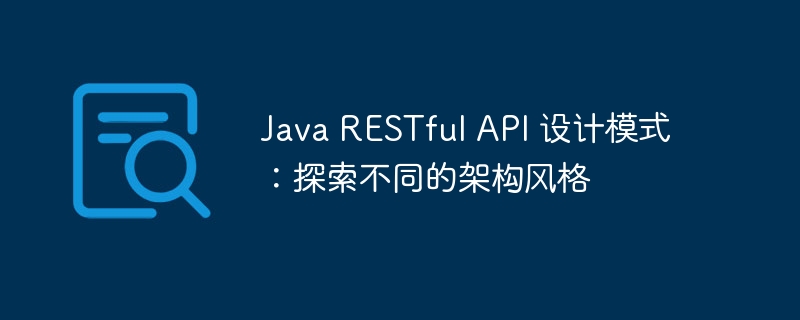Java RESTful API 设计模式:探索不同的架构风格

Java RESTful API 设计模式是现代软件开发中至关重要的一环。在这篇文章中,php小编草莓将带领大家探索不同的架构风格,深入了解RESTful API设计的关键概念和最佳实践。无论您是初学者还是经验丰富的开发人员,本文都将为您揭示如何通过合理的设计模式来构建高效、可维护的RESTful API,为您的项目增添更多优势。
1. RESTful 资源
RESTful 资源是 API 的核心组成部分。它们表示应用程序中感兴趣的实体,例如客户、产品或订单。资源使用 URI 标识,并且可以通过 Http 方法(GET、POST、PUT、DELETE)进行操作。
@Entity
public class Customer {
@Id
@GeneratedValue(strategy=GenerationType.AUTO)
private Long id;
private String name;
private String email;
// ...
}2. 超媒体
超媒体 API 提供额外的信息,例如可用操作的链接、格式规范和相关的资源。这使得客户端能够动态地浏览和交互 API,而无需事先了解其所有端点。
@GetMapping(produces = {MediaType.APPLICATION_HAL_JSON_VALUE})
public ResponseEntity<Resource<Customer>> getCustomer(@PathVariable Long id) {
Customer customer = customerService.findById(id);
Resource<Customer> resource = new Resource<>(customer);
resource.add(linkTo(methodOn(CustomerController.class).getCustomer(id)).withSelfRel());
resource.add(linkTo(methodOn(CustomerController.class).getAllCustomers()).withRel("customers"));
return ResponseEntity.ok(resource);
}3. HATEOAS
HATEOAS(超文本作为应用程序状态引擎)是一种 RESTful 架构模式,它使用超媒体让客户端了解可用操作和资源。通过将状态嵌入到 API 响应中,HATEOAS 消除了对文档的需要,并促进了 API 的可发现性。
@GetMapping(produces = {MediaType.APPLICATION_HAL_jsON_VALUE})
public ResponseEntity<Resource<Customer>> getCustomer(@PathVariable Long id) {
Customer customer = customerService.findById(id);
Resource<Customer> resource = new Resource<>(customer);
resource.add(linkTo(methodOn(CustomerController.class).getCustomer(id)).withSelfRel());
resource.add(linkTo(methodOn(CustomerController.class).getAllCustomers()).withRel("customers"));
resource.add(linkTo(methodOn(CustomerController.class).updateCustomer(id, null)).withRel("update"));
resource.add(linkTo(methodOn(CustomerController.class).deleteCustomer(id)).withRel("delete"));
return ResponseEntity.ok(resource);
}4. 微服务
微服务是一种架构风格,其中应用程序被分解为松散耦合的小服务。每个微服务负责一个特定功能,并通过 API 与其他服务进行通信。这种模式提高了可扩展性、灵活性,并且还简化了维护和部署。
@SpringBootApplication
public class CustomerMicroserviceApplication {
public static void main(String[] args) {
springApplication.run(CustomerMicroserviceApplication.class, args);
}
}
@RestController
@RequestMapping("/api/customers")
public class CustomerController {
@Autowired
private CustomerService customerService;
@GetMapping
public List<Customer> getAllCustomers() {
return customerService.findAll();
}
@GetMapping("/{id}")
public Customer getCustomer(@PathVariable Long id) {
return customerService.findById(id);
}
@PostMapping
public Customer createCustomer(@RequestBody Customer customer) {
return customerService.save(customer);
}
@PutMapping("/{id}")
public Customer updateCustomer(@PathVariable Long id, @RequestBody Customer customer) {
return customerService.update(id, customer);
}
@DeleteMapping("/{id}")
public void deleteCustomer(@PathVariable Long id) {
customerService.delete(id);
}
}选择最佳模式
选择合适的 RESTful API 设计模式取决于应用程序的特定要求。对于简单且静态的 API,RESTful 资源模型就足够了。对于更复杂的 API,超媒体或 HATEOAS 可以提供更好的可发现性。微服务模式适用于需要可扩展性和灵活性的大型应用程序。
结论
RESTful API 的设计模式提供了指导,帮助开发人员创建高效、可维护且可扩展的 API。通过了解不同的架构风格,您可以选择最适合您应用程序需求的模式,从而实现更好的 API 设计和交互。
以上是Java RESTful API 设计模式:探索不同的架构风格的详细内容。更多信息请关注PHP中文网其他相关文章!

热AI工具

Undresser.AI Undress
人工智能驱动的应用程序,用于创建逼真的裸体照片

AI Clothes Remover
用于从照片中去除衣服的在线人工智能工具。

Undress AI Tool
免费脱衣服图片

Clothoff.io
AI脱衣机

AI Hentai Generator
免费生成ai无尽的。

热门文章

热工具

记事本++7.3.1
好用且免费的代码编辑器

SublimeText3汉化版
中文版,非常好用

禅工作室 13.0.1
功能强大的PHP集成开发环境

Dreamweaver CS6
视觉化网页开发工具

SublimeText3 Mac版
神级代码编辑软件(SublimeText3)
 PHP框架与微服务:云原生部署和容器化
Jun 04, 2024 pm 12:48 PM
PHP框架与微服务:云原生部署和容器化
Jun 04, 2024 pm 12:48 PM
PHP框架与微服务相结合的好处:可扩展性:轻松扩展应用程序,添加新功能或处理更多负载。灵活性:微服务独立部署和维护,更容易进行更改和更新。高可用性:一个微服务的故障不影响其他部分,确保更高可用性。实战案例:使用Laravel和Kubernetes部署微服务步骤:创建Laravel项目。定义微服务控制器。创建Dockerfile。创建Kubernetes清单。部署微服务。测试微服务。
 Java 框架如何支持微服务的横向扩展?
Jun 04, 2024 pm 04:34 PM
Java 框架如何支持微服务的横向扩展?
Jun 04, 2024 pm 04:34 PM
Java框架支持微服务的横向扩展,具体方式包括:SpringCloud提供Ribbon和Feign用于服务器端和客户端负载平衡。NetflixOSS提供Eureka和Zuul,实现服务发现、负载平衡和故障转移。Kubernetes通过自动扩展、健康检查和自动重启简化了横向扩展。
 采用 Java 框架构建微服务架构面临的挑战?
Jun 02, 2024 pm 03:22 PM
采用 Java 框架构建微服务架构面临的挑战?
Jun 02, 2024 pm 03:22 PM
采用Java框架构建微服务架构涉及以下挑战:服务间通信:选择合适的通信机制,如RESTAPI、HTTP、gRPC或消息队列。分布式数据管理:维护数据一致性和避免分布式事务。服务发现和注册:集成SpringCloudEureka或HashiCorpConsul等机制。配置管理:使用SpringCloudConfigServer或HashiCorpVault集中管理配置。监控和可观察性:集成Prometheus和Grafana进行指标监控,同时使用SpringBootActuator提供操作指标。
 使用 Golang 微服务框架创建分布式系统
Jun 05, 2024 pm 06:36 PM
使用 Golang 微服务框架创建分布式系统
Jun 05, 2024 pm 06:36 PM
使用Golang微服务框架创建分布式系统:安装Golang、选择微服务框架(如Gin)创建Gin微服务,添加端点部署微服务,构建并运行应用程序创建订单和库存微服务,使用端点处理订单和库存使用Kafka等消息传递系统连接微服务使用sarama库生产和消费订单信息
 PHP框架与微服务:数据一致性与事务管理
Jun 02, 2024 pm 04:59 PM
PHP框架与微服务:数据一致性与事务管理
Jun 02, 2024 pm 04:59 PM
在PHP微服务架构中,数据一致性和事务管理至关重要。PHP框架提供机制来实现这些需求:使用事务类,如Laravel中的DB::transaction,来定义事务边界。使用ORM框架,如Doctrine,提供原子操作,如lock()方法,防止并发错误。对于分布式事务,考虑使用Saga或2PC等分布式事务管理器。例如,在线商店场景中使用事务,在添加到购物车时确保数据一致性。通过这些机制,PHP框架有效地管理事务和数据一致性,提高应用程序健壮性。
 如何部署和管理 Golang 微服务框架
Jun 02, 2024 pm 08:33 PM
如何部署和管理 Golang 微服务框架
Jun 02, 2024 pm 08:33 PM
如何部署和管理Golang微服务框架构建微服务:创建Go项目并使用mockgen生成基本服务模板。部署微服务:根据平台(例如Kubernetes或Docker)使用特定命令进行部署。管理微服务:监控(Prometheus、Grafana)、日志(Jaeger、Zipkin)、故障转移(Istio、Envoy)。
 Spring Boot 在微服务架构中扮演什么角色?
Jun 04, 2024 pm 02:34 PM
Spring Boot 在微服务架构中扮演什么角色?
Jun 04, 2024 pm 02:34 PM
SpringBoot在微服务架构中扮演着简化开发和部署的至关重要角色:提供基于注解的自动配置,处理常见配置任务,如数据库连接。通过契约测试支持验证API合约,减少服务之间的破坏性更改。具有生产就绪性功能,如度量收集、监视和健康检查,便于在生产环境中管理微服务。
 Guice框架中设计模式的应用
Jun 02, 2024 pm 10:49 PM
Guice框架中设计模式的应用
Jun 02, 2024 pm 10:49 PM
Guice框架应用了多项设计模式,包括:单例模式:通过@Singleton注解确保类只有一个实例。工厂方法模式:通过@Provides注解创建工厂方法,在依赖注入时获取对象实例。策略模式:将算法封装成不同策略类,通过@Named注解指定具体策略。






